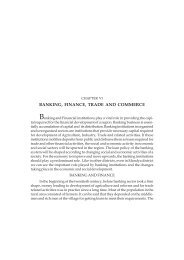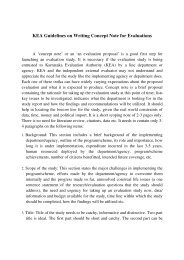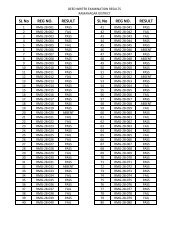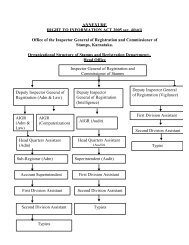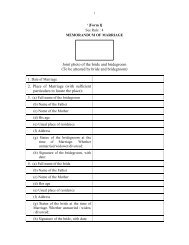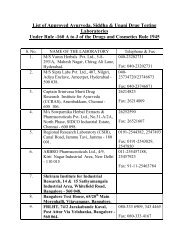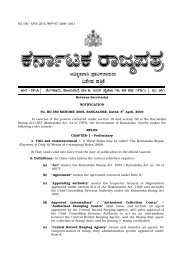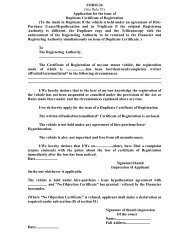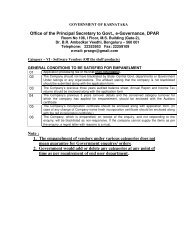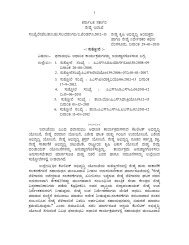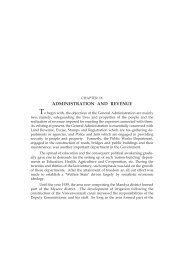Chapter XIII CULTURE - Government of Karnataka
Chapter XIII CULTURE - Government of Karnataka
Chapter XIII CULTURE - Government of Karnataka
You also want an ePaper? Increase the reach of your titles
YUMPU automatically turns print PDFs into web optimized ePapers that Google loves.
Culture 501<br />
<strong>of</strong> a vagrant husband whose exploits are finally discovered by the wife but<br />
paradoned immediately, true to spirit <strong>of</strong> ideal house wife. This as you may have<br />
thought is not a film story either. This is the story <strong>of</strong> our Lord Srikanteswara,<br />
<strong>of</strong> Nanjangud, who inspite <strong>of</strong> being wedded to the beautiful Deveri, had an<br />
affair going, with Chamundi, <strong>of</strong> the Chamundi hills. Or, take the story <strong>of</strong> Lord<br />
Ranganatha, <strong>of</strong> the Biligiri hills, who fell in love with a poor Soliga tribal girl -<br />
and married her. So much credence is given to this story by the local people,<br />
the Soligas, that they even to this day address Lord Ranganatha as ‘Bhava’, that<br />
is brother-in-law. These are stories which could make woderful film material,<br />
and it is no exaggeration if we say that the genesis <strong>of</strong> majority <strong>of</strong> film stories is<br />
the folk literature.<br />
When we say folk literature we do not always mean written literature only.<br />
Folk tradition in <strong>Karnataka</strong>, as elsewhere, began orally. The systematic study<br />
<strong>of</strong> folk literature was initiated by European scholars. Anyone who glances at the<br />
Kittel dictionary is sure to be amazed by the abundant collection <strong>of</strong> proverbs,<br />
most <strong>of</strong> which are <strong>of</strong> folk orgin. Kittel was helped in this by his immediate<br />
superior at the Basel Mission Church, Mangalore, Rev, Moegling. Abbe Dubois’<br />
work ‘Hindu Customs, Manners and Ceremonies’ contain a number <strong>of</strong> folk tales.<br />
May Frere’s ‘Old Deccan Day’ is an independent collection <strong>of</strong> folk tale. Among<br />
Kannadigas, Nadakeriyanda Chinnappa, a scholar from Kodagu, published in<br />
1924, a book in Kodava language called ‘Pattole Palame’, which was a collection<br />
<strong>of</strong> regional folklore with Kannada commentary. This was followed by Halasangi<br />
brothers <strong>of</strong> North <strong>Karnataka</strong> who published three volumes <strong>of</strong> folksongs and<br />
Ballads, titled ‘Garathiya Haadu,’ ‘Mallige Dande’ and ‘Jeevana Sangeetha’.<br />
Archaka B. Rangaswamy Bhatta <strong>of</strong> Mandya District brought out a book<br />
‘Huttida Halli Halliya Haadu’ which depicts the rural traditions <strong>of</strong> an entire<br />
village. During pre-independence period B.S. Gaddagimath was perhaps the<br />
first scholar in Kannada to secure a doctorate for his thesis on folklore. This<br />
was followed by Jee. Sham. Paramashivayya’s series <strong>of</strong> articles in Kannada<br />
Journals on folklore. Haa. Maa. Naik, a scholar in linguistics, published many<br />
papers on the study <strong>of</strong> folk culture. D. Javaregowda, as Vice-Chancellor <strong>of</strong><br />
Mysore University, established a Folklore Research Centre at Mysore. The<br />
Universities <strong>of</strong> Bangalore; Dharwad and Gulbarga, also <strong>of</strong>fer Doctoral Degrees<br />
in the study <strong>of</strong> folk culture. Of late Hampi Kannada University and Shimoga<br />
University have also been in the forefront.<br />
Dollu Kunita



